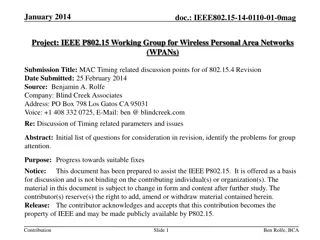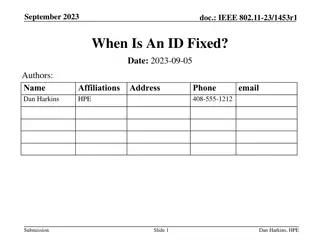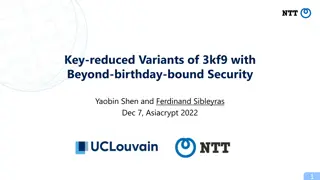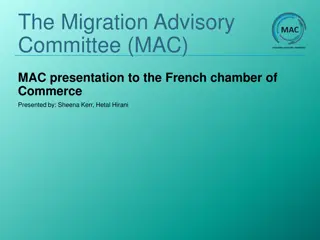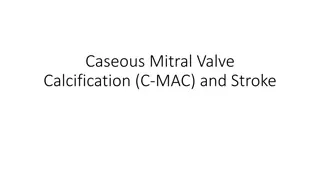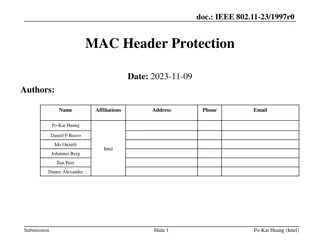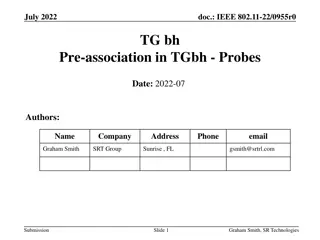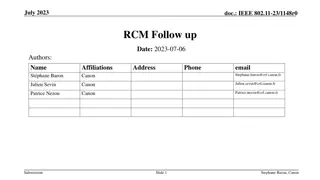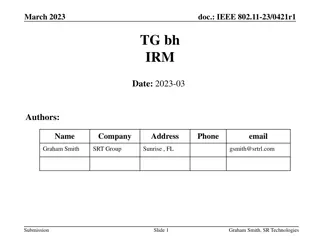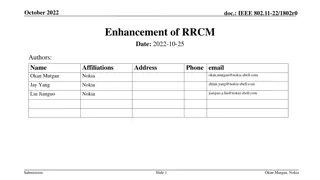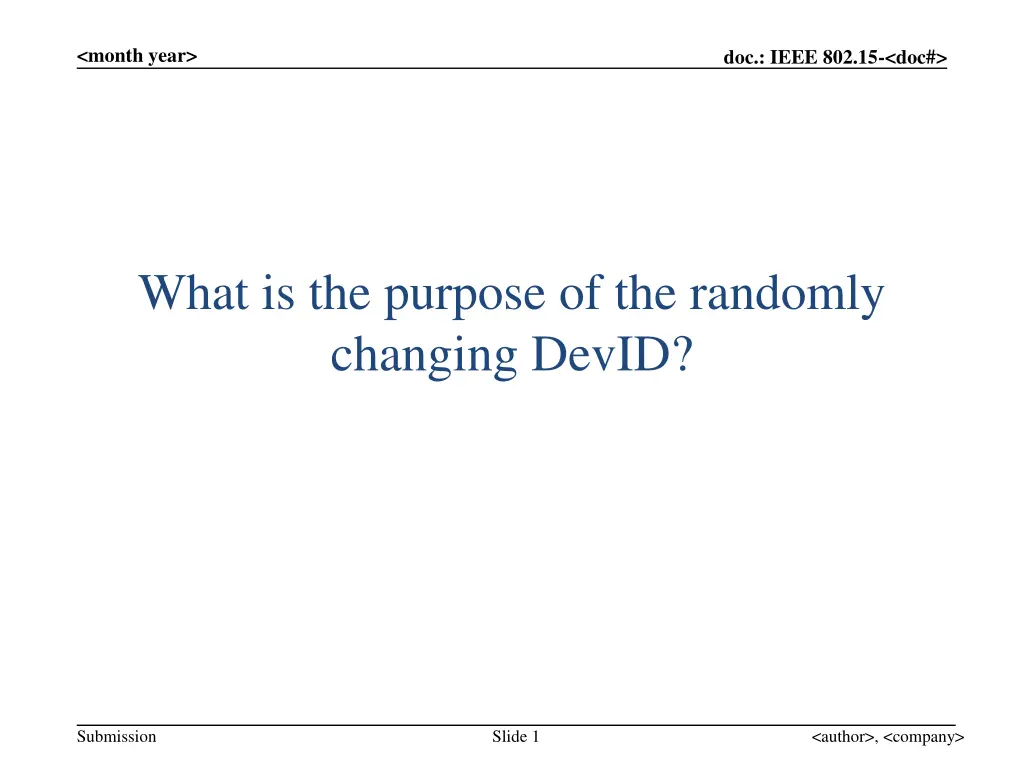
Randomly Changing DevID in IEEE 802.15 for Enhanced Security
Understand the significance of randomly changing DevID in IEEE 802.15 and its impact on security protocols. Discover the purpose behind this practice, the procedure for changing DevID per session, and the implications for maintaining a secure communication environment.
Download Presentation

Please find below an Image/Link to download the presentation.
The content on the website is provided AS IS for your information and personal use only. It may not be sold, licensed, or shared on other websites without obtaining consent from the author. If you encounter any issues during the download, it is possible that the publisher has removed the file from their server.
You are allowed to download the files provided on this website for personal or commercial use, subject to the condition that they are used lawfully. All files are the property of their respective owners.
The content on the website is provided AS IS for your information and personal use only. It may not be sold, licensed, or shared on other websites without obtaining consent from the author.
E N D
Presentation Transcript
<month year> doc.: IEEE 802.15-<doc#> What is the purpose of the randomly changing DevID? Submission Slide 1 <author>, <company>
<month year> doc.: IEEE 802.15-<doc#> Usage of Next DEVID Next DEVID indicates the DEVID value which will be assigned to the next associating device. When PPC creates a new session, PPC sends a Beacon with the new Next DEVID. A device which wishes to associate to the PPC shall set its DEVID with the Next DEVID value. Submission Slide 2 <author>, <company>
<month year> doc.: IEEE 802.15-<doc#> The purpose of randomly changing DevID If DevID is NOT changed, the previous DEV may continue to send frames to the PPC at any time even after the PPC has started a new P2P structure with new beacons. DevID needs to change per session. How to change the DevID 1. At random, with the value always changing. 2. Incremented by 1. What initial value shall be set? Only initial value shall be set randomly? Randomly changed DevID is better. Submission Slide 3 <author>, <company>
<month year> doc.: IEEE 802.15-<doc#> Beacon interval setting Submission Slide 4 <author>, <company>
<month year> doc.: IEEE 802.15-<doc#> Superframe Structure Unassociated Phase Unassociated Phase Associated Phase Setup Time < 2ms Beacon -Stop Beacon -Send Association Response instead. PPC can send Beacon with new Next DEVID PPAP PPAP Multiple transmission of Disassociation Request under Np-Ack policy are allowed. Association Response Beacon Beacon Access Slot Access Slot Access Slot PPC Disassociation Request DEV SIFS SIFS or RIFS SIFS Stk-Ack Association Request command Submission <author>, <company> Slide 5
<month year> doc.: IEEE 802.15-<doc#> Beacon Interval Beacon Interval consists of a SIFS and N AccessSlots. Time length of AccessSlot is basically defined as time length of an Association Request command plus a SIFS. Beacon Beacon Beacon Access Slot Access Slot Access Slot Access Slot Access Slot Access Slot PPC SIFS DEV SIFS SIFS Association Request command Submission <author>, <company> Slide 6
<month year> doc.: IEEE 802.15-<doc#> Time duration Beacon, Association Request command: about 3.2 us MCS0, w/PW =2.2587Gbps 2.328 us 0.69 us about 0.1 us Beacon payload (14 oct + IE) Association Req (15 oct + IE) FCS (4 oct) Long Preamble PHY header MAC Header (10 oct) SIFS(default) : 2.5 us AccessSlot: about 5.7 us Submission Slide 7 <author>, <company>
<month year> doc.: IEEE 802.15-<doc#> Collision Probability of Association Request command (1/2) Assumption 2 DEV s which want to connect to a PPC are near the PPC. No need to consider case of more than 2 DEV s. Collision avoidance probability should be kept above 90%. 2) 2DEV s are near a PPC 1) a DEV is near a PPC PPC PPC less than 10cm DEV1 DEV2 DEV1 Collision does not occur Submission Slide 8 <author>, <company>
<month year> doc.: IEEE 802.15-<doc#> Example Expected Duration 1) K =1 Beacon Beacon Beacon Beacon Access Slot Access Slot Access Slot PPC SIFS SIFS SIFS no collision no collision probability = (N-1) / N DEV1 DEV2 Expected Duration 2) K =2 Beacon Beacon Beacon Beacon Access Slot Access Slot Access Slot PPC SIFS SIFS SIFS no collision collision collision probability = 1 / N no collision probability = (N-1) / N DEV1 DEV2 DEV1 DEV2 Submission Slide 9 <author>, <company>
<month year> doc.: IEEE 802.15-<doc#> Collision Probability of Association Request command (2/2) Relation between K and N to bring collision probability below 10%, K (1/N)i-1((N-1)/N) >= 90% i=1 where N= number of AccessSlot K = minimum number of Beacons necessary to bring collision probability below 10%. Expected Duration(ED(K,N)) to bring collision probability below 10%, ED(K,N) = K (Beacon + SIFS) +K N AccessSlot. Submission Slide 10 <author>, <company>
<month year> doc.: IEEE 802.15-<doc#> Conclusion Calculation Results K 1 2 2 N 10 9 5 8 Expected duration (CP is less than 10%) 1 (Beacon + SIFS) +10 Access Slot 2 (Beacon + SIFS) + 18 Access Slot 2 (Beacon + SIFS) + (10 16) Access Slot Value[us] 62.7 114 68.4 102.6 57 68.4 68.4 2 3 4 4 3 2 2 (Beacon + SIFS) + 8 Access Slot 3 (Beacon + SIFS) + 9 Access Slot 4 (Beacon + SIFS) + 8 Access Slot Conclusion N=4 is optimum, where the expected duration becomes shortest. When the number of AccessSlots per Beacon is set 4, then Beacon interval equals about 28.5us. Submission Slide 11 <author>, <company>
<month year> doc.: IEEE 802.15-<doc#> Define a MAC/PHY interface for the OOK and SC PHYs. Submission Slide 12 <author>, <company>
<month year> doc.: IEEE 802.15-<doc#> PHY SAP service Primitives PHY-CCA primitives are not required, since HRCP does not use Carrier Sense mechanism. Remove Submission Slide 13 <author>, <company>
<month year> doc.: IEEE 802.15-<doc#> PHY SAP service Primitive Parameters CCA Status parameter is not required. LQI (Link Quality Indication) is not required, since HRCP does not support TCM coded QAM mode using an SNR estimation. SC, MIMO and OOK parameters may be added after completing PHY discussion. Remove Remove Submission Slide 14
<month year> doc.: IEEE 802.15-<doc#> What is Link Quality indication? Submission Slide 15 <author>, <company>
<month year> doc.: IEEE 802.15-<doc#> Correcting the use of MLME Association.indication Submission Slide 16 <author>, <company>
<month year> doc.: IEEE 802.15-<doc#> Remove second MLME Associate.ind DEV-1 DME DEV-1 MAC/MLME PPC PPC DME MAC/MLME Unassociated Beacon NEXT DEVID = 0xZZ KEY req=request ind=indication rsp=response cfm=confirm addr=address MLME-ASSOCIATE.req Association Request command - DEVID = 0xZZ - DEV addr =DEV-1 addr AssocTimout MLME ASSOCIATE.ind - DEVID = 0xZZ - DEV addr =DEV-1 addr MLME ASSOCIATE.rsp - DEVID = 0xZZ - DEV addr =DEV-1 addr Stop Beacon Association Response command - DEVID = 0xZZ - DEV addr =DEV-1 addr Remove AssocTimout MLME ASSOCIATE.ind - DEVID = 0xZZ - DEV addr =DEV-1 addr Stk-Ack - SrcID= 0xZZ MLME-ASSOCIATE.cfm - DEVID= 0xxZZ Submission <author>, <company> Slide 17
<month year> 802.15.3 MLME Associate.ind process doc.: IEEE 802.15-<doc#> DEVID= UnassocID DEVID= 0xZZ Submission Slide 18 <author>, <company>





